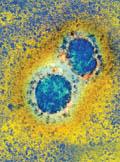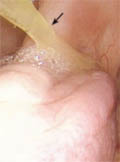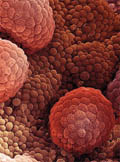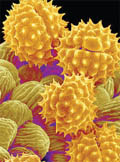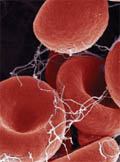The eLitMed.hu medical portal uses computer cookies for convenient operation. Detailed information can be found in the Cookie-policy.
Lege Artis Medicinae - 2011;21(06-07)
Content
[Changes in infectology over the past two decades]
[Infectious diseases and various infections are the major causes of morbidity and mortality in developing as well as in industrialised countries. Despite the advances in the past decades in our understanding of microbes, efficient treatment of diseases and preventive approaches, more than 13 million people die every year due to infectious diseases. In the past two decades, more and more new pathogens and infections diseases have been emerging and old diseases that were almost forgotten have re-emerged. There are many new diseases for which we do not have or have hardly any efficient antimicrobial drugs and no efficient vaccines. Despite an increasing frequency of multi- and panresistant microbes, the development of new antibiotics to be used against these infections is unlikely to occur in the near future. The big pharmaceutical companies have stopped the research of antibiotics. In this situation, the only option we have is to use antibiotics rationally and to take prevention and control of infections seriously, both in the outpatient system and in hospitals. Preserving the effectiveness of currently used antibiotics is in everyone’s interest and is everyone’s responsibility.]
[The role and significance of vascular aging in the risk stratification of cardiovascular prevention]
[The structure and function of arteries change throughout one’s lifetime. The most important changes include lumenal dilation, diffuse intimal and medial thickening, increased stiffness, reduced compliance of central arteries and endothelial dysfunction. Arterial stiffness, an increased pulse wave velocity (PWV) and an increased carotid intima-media thickness (IMT) are independent predictors of cardiovascular events. The early vascular aging (EVA) could help clinicians to determine the increased cardiovascular risk. EVA can be be determined by noninvasive methods, as arterial stiffness and carotid IMT. EVA can be suitable for the early detection of cardiovascular diseases.]
[A new approach to the treatment of diabetic retinopathy - PPAR-α agonist activity of fenofibrate]
[Diabetic retinopathy (DR) is a leading cause of visual impairment worldwide. It affects nearly half of patients with diabetes and its severity increases with the progress of diabetes. Glycotoxicity, lipotoxicity and hypertension are the main risk factors for the development of DR. The control of glucose homeostasis and blood pressure are the main noninvasive approaches that might have a role in the treatment of this condition. On the basis of new studies, RAS inhibitors and fenofibrate are promising candidates that can be used to retard DR progression and/or induce its regression. Two large-scale studies (FIELD, ACCORD Eye) have demonstrated that fenofibrate therapy significantly reduces the need for laser treatment of DR. The efficiency of this therapy, which is independent of lipid changes, is primarily attributable to the PPAR-α agonist activity of fenofibrates. According to guidelines that discuss the new therapeutic approaches of DR, fibrate therapy is a promising new option for preventing the progression of DR.]
[Antidiabetic therapy of patients with type 2 diabetes - The place of administration of acarbose]
[Administration of the alpha-glucosidase enzyme inhibitor acarbose leads to a prolonged absorption of carbohydrates, which has a smoothing effect on blood glucose excursions, and results in a more even daily blood glucose profile. The glucose lowering effect is mainly due to the reduction of postprandial blood glucose levels. Non-glycaemic effects of acarbose, including those on blood pressure, lipids and the coagulation system are also clearly beneficial. According to the available data, the preparation also reduces cardiovascular risk. If used as a monotherapy, acarbose does not cause hypoglycaemia. Flatulence and diaorrhea represent the main side effects. From a professional point of view, acarbose should be given if postprandial blood glucose excursions exceed 2.2 mmol/l.]
[Oral allergy syndrome in childhood]
[As the prevalence of pollen allergy is increasing, the incidence of oral allergy syndrome is becoming more frequent. We expect, therefore, an increasing incidence of this syndrome among in children as well. The prevalence of oral allergy syndrome among adults with birch pollen allergy is estimated to be 20-70%. The prevalence of the disease among children is currently unknown. The aims of our study were to identify the characteristics of oral allergy syndrome in children and to assess its frequency. In order to identify children with oral allergy syndrome, we have used the children’s medical history, measured total IgE and serum specific IgE levels, performed skin prick tests and food challenge tests. Among the 743 children suffering from allergic rhinitis and/or bronchial asthma we found 463 children with pollen allergy, 6 of who had oral allergy syndrome. Thus, the prevalence of oral allergy syndrome among children with pollen allergy was 1.3%.]
[Inhibition of thrombocyte aggregation in patients with lower-limb vasoconstriction - Do we really treat them well?]
[Due to the prevalence and significant mortality of peripheral vascular diseases, their treatment requires special attention. PATIENTS - We examined 45 patients awaiting vascular surgery at the Department of Cardiovascular Surgery at Semmelweis University. RESULTS - We have demonstrated that the routine administration of acetylsalicylic acid was ineffective in the majority (60%) of patients, especially in the at-risk groups. In contrast, clopidogrel therapy was ineffective in only 11% of patients. CONCLUSIONS - On the basis of the literature and our own studies, we consider clopidogrel as the first-choice drug for the inhibition of thrombocyte aggregation in all patients with vascular disease, and for primary prevention in at-risk groups.]
[Committed physicians, emotional resonance for a better physician-patient relationship]
[With the advent of holistic medicine in the second half of the 20th century, the range of behavioural patterns that are expected from healthcare workers has also changed. Nowadays, numerous references in literature put emphasis on the potential positive impact of personal interactions between physician and patient on the healing process and overall well-being of patients. However, it does not come naturally to all workers with caring professions to seek personal interactions with their patients or display appropriate emotions. Some will have to make deliberate efforts, perform emotional labour, to achieve that goal. A healthcare worker’s commitment to healing and caring may make it easier for him/her to perform emotional labour. Emotional labour and commitment of 84 healthcare workers involved in oncology, and organizational factors with impact thereupon, were studied to explore the potential relationship between commitment and emotional labour. PANAS-X questionnaires were used to quantify emotional labour, while commitment and influencing factors were surveyed by means of explicative questions. Our findings confirmed a correlation between commitment and genuine acting as corroborated by literaure data. It was demonstrated that committed healthcare workers’ spontaneous emotions were more in compliance with what their patients expected them to display, and even their behavioural patterns were more in tune with the patients’ expectations. Confirmation as an organizational factor and colleague/ patient attitudes were found to have the strongest impact on commitment. It is essential that selection criteria for healthcare workers include examination for an altruistic caring attitude. Even more importantly, operators and managers of healthcare institutes should make efforts to create a good working environment and offer regular confirmative feedbacks for improved commitment by their employees.]
1.
Clinical Neuroscience
Is there any difference in mortality rates of atrial fibrillation detected before or after ischemic stroke?2.
Clinical Neuroscience
Factors influencing the level of stigma in Parkinson’s disease in western Turkey3.
Clinical Neuroscience
Neuropathic pain and mood disorders in earthquake survivors with peripheral nerve injuries4.
Journal of Nursing Theory and Practice
[Correlations of Sarcopenia, Frailty, Falls and Social Isolation – A Literature Review in the Light of Swedish Statistics]5.
Clinical Neuroscience
[Comparison of pain intensity measurements among patients with low-back pain]1.
Clinical Neuroscience Proceedings
[A Magyar Stroke Társaság XVIII. Kongresszusa és a Magyar Neuroszonológiai Társaság XV. Konferenciája. Absztraktfüzet]2.
3.
Journal of Nursing Theory and Practice
[A selection of the entries submitted to the literary contest "Honorable mission: the joys and challenges of our profession" ]4.
Journal of Nursing Theory and Practice
[End of Life and Palliative Care of Newborns in the Nursing Context]5.
Journal of Nursing Theory and Practice
[Aspects of Occupational Health Nursing for Incurable Patients ]



